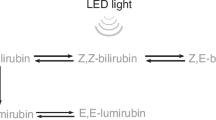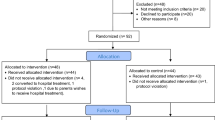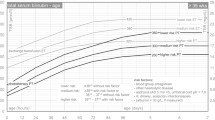Abstract
Background
Phototherapy with blue light matching plasma absorption spectrum of the bilirubin–albumin complex with peak at 460 nm is standard treatment of neonatal hyperbilirubinemia.
Aim
To demonstrate clinically the action (efficacy) spectrum of phototherapy in hyperbilirubinemic neonates, through determination of the fraction of total serum bilirubin (TSB) decreased by phototherapy with peak emission wavelengths ≥478 nm (blue-green) compared with that of light of 459/452 nm (blue).
Methods
TSB values were compiled from three earlier trials, in which hyperbilirubinemic neonates were randomized to receive 24 h of either blue-green light (478/490/497 nm) (intervention groups) or blue light (459/452/459 nm) (control groups) with equal irradiance and exposed body surface areas. Ratios (efficacy) between the decrease in TSB between intervention and control groups were calculated and graphed versus peak wavelengths, demonstrating the course of the action spectrum.
Results
Calculated efficacy ratios were 1.31, 1.18, and 1.04 for light with peak wavelengths of 478, 490, and 497 nm, respectively. The action spectrum increases from 452/459 to maximum at 478 nm, from where it decreases to 1.18 and finally to 1.04.
Conclusion
For optimal phototherapeutic treatment, neonates need to be exposed to light with peak wavelength some 20 nm longer than is presently used.
Impact
-
The action (efficacy) spectrum of phototherapy for hyperbilirubinemic neonates has its peak wavelength at 478 nm.
-
The peak wavelength of this action spectrum is 20 nm longer than the wavelength presently believed to be most efficient. The peak is also different from the peak found in vitro.
-
For optimal phototherapeutic effect, neonates need to be treated with light of wavelengths some 20 nm longer than are presently used.
Similar content being viewed by others
Log in or create a free account to read this content
Gain free access to this article, as well as selected content from this journal and more on nature.com
or
References
American Academy of Pediatrics, Subcommittee on Hyperbilirubinemia. Management of hyperbilirubinemia in the newborn infant 35 or more weeks of gestation. Pediatrics 114, 297–316 (2004).
Pichon, J.-B., Riordan, S. M., Watchko, J. & Shapiro, S. The neurological sequelae of neonatal hyperbilirubinemia: definitions, diagnosis and treatment of the kernicterus spectrum disorders (KSDs). Curr. Pediatr. Rev. 13, 199–209 (2017).
Watchko, J. F. & Maisels, M. J. The enigma of low bilirubin kernicterus in premature infants: why does it still occur, and is it preventable? Semin. Perinatol. 38, 397–406 (2014).
Donneborg, M. L., Hansen, B. M., Vandborg, P. K., Rodrigo-Domingo, M. & Ebbesen, F. Extreme neonatal hyperbilirubinemia and kernicterus spectrum disorder in Denmark year 2000–2015. J. Perinatol. 40, 194–202 (2020).
Iskander, I. et al. Serum bilirubin and bilirubin/albumin ratio as predictors of bilirubin encephalopathy. Pediatrics 134, 1330–1339 (2014).
Farouk, Z. L. et al. Follow-up of children with kernicterus in Kano, Nigeria. J. Trop. Pediatr. 64, 176–182 (2018).
Alken, J., Haakansson, S., Ekeus, C., Gustafson, P. & Norman, M. Rates of extreme neonatal hyperbilirubinemia and kernicterus in children and adherence to national guidelines for screening, diagnosis, and treatment in Sweden. JAMA Netw. Open 2, e190858 (2019).
Toenne, A., Meberg, A. & Hager, H. B. Erindring i diagnostik og behandling av hyperbilirubinemi hos nyfødte. Tidskr. Nor. Legeforen. 130, 18–24 (2010). Article in Norwegian.
Mreihil, K., Benth, J. S., Stensvold, H. J., Nakstad, B. & Hansen, T. W. R. Phototherapy is commonly used for jaundice but greater control is needed to avoid toxicity in the most vulnerable infants. Acta Paediatr. 107, 611–619 (2018).
Cremer, R. J., Perryman, P. W. & Richards, D. H. Influence of light on the hyperbilirubinemia of infants. Lancet 24, 1094–1097 (1958).
Ennever, J. F., McDonagh, A. F. & Speck, W. T. Phototherapy for neonatal jaundice: optimal wavelengths of light. J. Pediatr. 103, 295–299 (1983).
Vreman, H. J., Wong, R. J., Murdock, J. R. & Stevenson, D. K. Standardized bench method for evaluating the efficacy of phototherapy devices. Acta Paediatr. 97, 308–316 (2008).
Vecchi, C., Donzelli, G. P., Migliorini, M. G. & Sbrana, G. Green light in phototherapy. Pediatr. Res. 17, 461–463 (1983).
Tan, K. L. Efficacy of fluorescent daylight, blue, and green lamps in the management of nonhemolytic hyperbilirubinemia. J. Pediatr. 114, 132–137 (1989).
Amato, M. & Inaebnit, D. Clinical usefulness of high intensity green light phototherapy in the treatment of neonatal jaundice. Eur. J. Pediatr. 150, 274–276 (1991).
Parshad, R., Sanford, K. K., Jones, G. M. & Tarone, R. E. Fluorescent light-induced chromosome damage and its prevention in mouse cells in culture. Proc. Natl Acad. Sci. USA 75, 1830–1833 (1978).
Roll, E. B. & Christensen, T. Formation of photoproducts and cytotoxicity of bilirubin irradiated with turquoise and blue phototherapy light. Acta Paediatr. 94, 1448–1454 (2005).
Uchida, Y. et al. Phototherapy with blue and green mixed light is as effective against unconjugated jaundice as blue light and reduces oxidative stress in the Gunn rat model. Early Hum. Dev. 97, 381–385 (2015).
Gutcher, G. R., Yen, W. M. & Odell, G. B. The in vitro and in vivo photoreactivity of bilirubin: I. Laser-defined wavelength dependence. Pediatr. Res. 17, 120–123 (1983).
McDonagh, A. F., Agati, G., Fusi, F. & Pratesi, R. Quantum yields for laser photocyclization of bilirubin in the presence of human serum albumin. Dependence on quantum yield of excitation wavelength. Photochem. Photobiol. 50, 305–319 (1989).
Greenberg, J. W., Malhotra, V. & Ennever, J. F. Wavelength dependence of the quantum yield for the structural isomerization of bilirubin. Photochem. Photobiol. 46, 453–456 (1987).
Vreman, H. J. et al. The effect of light wavelength on in vitro bilirubin photodegradation and photoisomer production. Pediatr. Res. 85, 865–873 (2019).
Onishi, S., Itoh, S. & Isobe, K. Wavelength-dependence of the relative rate constants for the main geometric and structural photoisomerization of bilirubin IXα bound to human serum albumin. Biochem. J. 236, 23–29 (1986).
Pratesi, R. et al. Skin optics and phototherapy of jaundice. Photochem. Photobiol. 40, 77–83 (1984).
Agati, G., Fusi, F., Donzelli, G. P. & Pratesi, R. Quantum yield and skin filtering effects on the formation of lumirubin. J. Photochem. Photobiol. B 18, 197–203 (1993).
Lamola, A. A., Bhutani, V. K., Wong, R. J., Stevenson, D. K. & McDonagh, A. F. The effect of hematocrit on the efficacy of phototherapy for neonatal jaundice. Pediatr. Res. 74, 54–60 (2013).
Lamola, A. A. A pharmacologic view of phototherapy. Clin. Perinatol. 43, 259–276 (2016).
Ebbesen, F., Madsen, P., Stoevring, S., Hundborg, H. & Agati, G. Therapeutic effect of turquoise versus blue light with equal irradiance in preterm infants with jaundice. Acta Paediatr. 96, 837–841 (2007).
Ebbesen, F. et al. Effect of phototherapy with turquoise vs. blue LED light of equal irradiance in jaundiced neonates. Pediatr. Res. 79, 308–312 (2016).
Ebbesen, F., Rodrigo-Domingo, M., Moeller, A. M., Vreman, H. J. & Donneborg, M. L. Effect of blue LED phototherapy centered at 478 nm versus 459 nm in hyperbilirubinemic neonates: a randomized study. Pediatr. Res. 89, 598–603 (2021).
Jobling, J., Henry, E., Wiedmeier, S. E. & Christensen, R. D. Reference ranges for hematocrit and blood hemoglobin concentration during the neonatal period: data from a multihospital health care system. Pediatrics 123, e333–e337 (2009).
Morris, B. H. et al. Aggressive vs. conservative phototherapy for infants with extremely low birth weight. N. Engl. J. Med. 359, 1885–1889 (2008).
American Academy of Pediatrics, Bhutani, V. K., The Committee on Fetus and Newborn. Phototherapy to prevent severe neonatal hyperbilirubinemia in the newborn infant 35 or more weeks of gestation. Pediatrics 128, e1046–e1052 (2011).
Plavskii, V. Y., Tretyakova, A. I. & Mostovnikova, G. R. Phototherapeutic systems for treatment of hyperbilirubinemia of newborns. J. Opt. Technol. 81, 341–348 (2014).
Donneborg, M. L., Vandborg, P. K., Hansen, B. M., Rodrigo-Domingo, M. & Ebbesen, F. The impact of hemoglobin on the efficacy of phototherapy in hyperbilirubinemic infants. Pediatr. Res. 82, 947–951 (2017).
Vreman, H. J., Wong, R. J. & Stevenson, D. K. Phototherapy: current methods and future directions. Semin. Perinatol. 28, 326–333 (2004).
Christensen, T., Kinn, G., Granli, T. & Amundsen, I. Cells, bilirubin and light: formation of bilirubin photoproducts and cellular damage at defined wavelengths. Acta Paediatr. 83, 7–12 (1994).
Cristensen, T., Reitan, J. B. & Kinn, G. Single-strand breaks in the DNA of human cells exposed to visible light from phototherapy lamps in the presence and absence of bilirubin. J. Photochem. Photobiol. B Biol. 7, 337–346 (1990).
Van der Schoor, L. W. E. et al. LED-phototherapy does not induce oxidative DNA damage in hyperbilirubinemic Gunn rats. Pediatr. Res. 85, 1041–1047 (2019).
Newman, T. B. et al. Retrospective cohort study of phototherapy and childhood cancer in Northern California. Pediatrics 137, e20151354 (2016).
Jasprova, J. et al. Neuro-inflammatory effects of photodegradative products of bilirubin. Sci. Rep. 8, 7444 (2018).
Gloria-Bottini, F. & Bottini, E. Is there a role of early neonatal events in susceptibility to allergy? Int. J. Biochem. Sci. 6, 8–12 (2010).
Rubaltelli, F. F., Allegri, G., Costa, C. & De Antoni, A. Urinary excretion of tryptophan metabolities during phototherapy. J. Pediatr. 85, 865–867 (1974).
Itoh, S., Okada, H., Kuboi, T. & Kusaka, T. Phototherapy for neonatal hyperbilirubinemia. Pediatr. Int. 59, 959–966 (2017).
Seidman, D. et al. A prospective randomized controlled study of phototherapy using blue and blue-green light-emitting devices, and conventional halogen-quartz phototherapy. J. Perinatol. 23, 123–127 (2003).
Kuboi, T. et al. Green light-emitting diode phototherapy for neonatal hyperbilirubinemia: randomized controlled trial. Pediatr. Intern. 61, 465–470 (2019).
Acknowledgements
We thank John Mahoney for review of the manuscript and Lene Pedersen for drafting Fig. 1.
Author information
Authors and Affiliations
Contributions
F.E. conceptualized and designed the study, drafted the initial manuscript, reviewed, and revised the manuscript. M.L.D. and P.K.V. reviewed and made recommendations towards improvement of the manuscript. H.J.V. made substantial contributions to the initial manuscript, reviewed, and made recommendations towards improvement of the final manuscript. All authors approved the final version to be published.
Corresponding author
Ethics declarations
Competing interests
The authors declare no competing interests.
Patient consent and approval
Patient consent is not required, as the study does not contain any new data. It is a comparison of data published in our three previous articles. These three have all been approved by the Ethics Committee of North Jutland Region.
Additional information
Publisher’s note Springer Nature remains neutral with regard to jurisdictional claims in published maps and institutional affiliations.
Rights and permissions
About this article
Cite this article
Ebbesen, F., Donneborg, M.L., Vandborg, P.K. et al. Action spectrum of phototherapy in hyperbilirubinemic neonates. Pediatr Res 92, 816–821 (2022). https://doi.org/10.1038/s41390-021-01743-9
Received:
Revised:
Accepted:
Published:
Issue date:
DOI: https://doi.org/10.1038/s41390-021-01743-9
This article is cited by
-
Efficacy of phototherapy of neonatal jaundice – light wavelength matters
Pediatric Research (2025)
-
Bilirubin isomers during LED phototherapy of hyperbilirubinemic neonates, blue–green (~478 nm) vs blue
Pediatric Research (2025)



